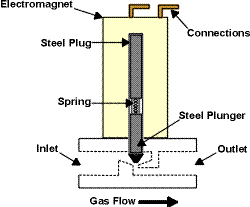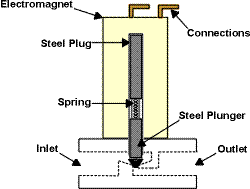Dave's Place
Gas Solenoid Valve

Before working with the propane system, visit the Gas safety page.
The gas solenoid consists of a 12 volt electromagnet mounted on top of a valve body. When activated, the electromagnet pulls up a steel plunger inside the valve body allowing the flow of propane. (See below) 12 volt is applied to the connections of the solenoid valve by a circuit board or DSI board to activate the electromagnet. Unless otherwise noted, there is no polarity for these connections (it doesn't make any difference which one is positive or negative).
When 12 volt power to the solenoid is discontinued, the electromagnet is de-energized and the plunger snaps shut, cutting off the flow of propane through the valve.(See below) There are no gas safety mechanisms built into the gas solenoid valve. Instead, the safety mechanisms are supplied by the circuit board or DSI board, each of which would shut off the power to the solenoid if there was a flame failure.

Troubleshooting
There's not much to troubleshooting the gas solenoid valve. If the valve is not opening, test for 12
volt across the connections with a test light or meter. If power is present and the valve doesn't open,
the solenoid valve is bad. If power is not present, the problem is away from the gas solenoid valve.
You could also apply 12 volt to the solenoid connections to test its operation. Before doing this, however, be sure to disconnect the existing connections to the solenoid, so you don't run the risk of damaging the circuit board or DSI board that controls it.
If the gas solenoid valve fails to open when it should or, even worse, fails to close, replace it. The gas solenoid valve is not repairable since some parts are machine pressed together.
Dometic Electronic System (second generation)
RV Refrigerator Home
This RV refridgerator information was originally located on rvmobile.comRV Mobile Inc. 11715 HWY 99, Everett, WA 98204
The owner of RV Mobile Inc. apparently suffered a heart attack and the original website was shut down.
It has been reposted here to preserve this wealth of information RV refridgerator information.